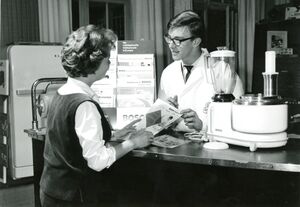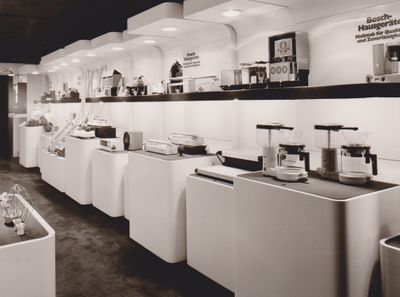Robert Bosch GmbH/en: Unterschied zwischen den Versionen
(Die Seite wurde neu angelegt: „==== From automotive supplier to electronics corporation ====“) |
(Die Seite wurde neu angelegt: „thumb|1962: A salesman is giving advice in the Bosch store in Stuttgart. (Source: Robert Bosch GmbH - Corporate Archives, signature 6 001 17486) The reconstruction following the war years progressed successfully. Most of the foreign subsidiaries were rebuilt and some new ones added. The product range was expanded to include a host of new innovations, including a diesel injection pump in addition t…“) |
||
| Zeile 15: | Zeile 15: | ||
==== From automotive supplier to electronics corporation ==== | ==== From automotive supplier to electronics corporation ==== | ||
[[File:1962 Verkaufshaus Stuttgart 1962 rbosch 17486.jpg|thumb|1962: A salesman is giving advice in the Bosch store in Stuttgart. (Source: Robert Bosch GmbH - Corporate Archives, signature 6 001 17486)]] | |||
[[ | The reconstruction following the war years progressed successfully. Most of the foreign subsidiaries were rebuilt and some new ones added. The product range was expanded to include a host of new innovations, including a diesel injection pump in addition to vehicle lighting, windshield wipers and power brakes. Further production branches were added by the mid-1930s, with production of home appliances commencing in 1933 with the [[The_first_Bosch_refrigerator_–_a_round_affair|first electric refrigerator]]. Robert Bosch AG transformed itself at this time from a pure automotive supplier to a broadly diversified electronics corporation. Robert Bosch turned the public limited company (AG) into a limited liability company (GmbH) in keeping with his "... desire that Robert Bosch GmbH (...) remains active for as many generations as possible, securing their financial independence, their autonomy and capacity to act at all times." | ||
<div lang="de-x-formal" dir="ltr" class="mw-content-ltr"> | <div lang="de-x-formal" dir="ltr" class="mw-content-ltr"> | ||
Version vom 1. August 2023, 13:59 Uhr
Robert Bosch GmbH established Bosch-Siemens-Hausgeräte GmbH[1] in 1967 together with Siemens AG. But the history of the company Bosch dates back further than that to 1886 when Robert Bosch opened his "Workshop for Precision Mechanics and Electrical Engineering" in Stuttgart. Now a global concern, this is where the company started out as a small production, maintenance and repair business.
"Workshop for Precision Mechanics and Electrical Engineering" in Stuttgart
Following his apprenticeship training as a precision mechanic, the aspiring entrepreneur Robert Bosch worked for Schuckert & Co[2] in Nuremberg among other companies during the 1880s. Having spent a semester at the Technical University in Stuttgart studying electrical engineering and then working in the U.S., Bosch also worked for Siemens Brothers in England. The paths of the future partner companies had therefore already crossed well before BSH was established.
Robert Bosch opened his "Workshop for Precision Mechanics and Electrical Engineering" in Stuttgart on November 15, 1886. In the early years, he was still carrying out all precision mechanics and electrical engineering work himself. On October 8, 1887, the workshop for the first time supplied the product for which Bosch would soon become famous: the Bosch magneto ignition device for combustion engines, initially at the time for stationary engines. By 1891, the manufacture of the magneto ignition device was already accounting for more than 50 percent of revenue. Despite this, business was often sluggish in the first ten years. Robert Bosch himself later described this time as a "shambles". The situation had improved by 1895 with the construction of the power plant in Stuttgart. Homes and businesses in Stuttgart were now increasingly supplied with electricity, with the result that the demand for electrical engineering grew rapidly. The 1000th magneto ignition device for stationary engines was produced in 1896 – to mark the day, Robert Bosch invited his employees to a company outing in a nearby hostelry. The following year, the company succeeded in making a technical breakthrough with the construction of magneto ignition devices for automobile engines. The first office outside Germany was opened in England in 1898, followed a year later by branches in France and Austria-Hungary. The greatest success achieved abroad by the Robert Bosch company however was in the U.S. Orders worth over a million dollars were landed on the first U.S. foray. By 1912 at the latest, the U.S. had become the most important sales market for the company with the opening of a local facility in Springfield. When the First World War broke out two years later, the German company lost its entire foreign market. The Bosch properties in the countries of the Triple Entente, material values as well as patents and property rights were confiscated. Production in Germany was switched to armaments.
Robert Bosch AG was founded in 1917 while the war was still raging.[3]
From automotive supplier to electronics corporation
The reconstruction following the war years progressed successfully. Most of the foreign subsidiaries were rebuilt and some new ones added. The product range was expanded to include a host of new innovations, including a diesel injection pump in addition to vehicle lighting, windshield wipers and power brakes. Further production branches were added by the mid-1930s, with production of home appliances commencing in 1933 with the first electric refrigerator. Robert Bosch AG transformed itself at this time from a pure automotive supplier to a broadly diversified electronics corporation. Robert Bosch turned the public limited company (AG) into a limited liability company (GmbH) in keeping with his "... desire that Robert Bosch GmbH (...) remains active for as many generations as possible, securing their financial independence, their autonomy and capacity to act at all times."
In der Zeit des Nationalsozialismus verhält sich das Unternehmen ähnlich wie andere deutsche Familienunternehmen, die von politisch liberal eingestellten und europäisch denkenden Persönlichkeiten geführt werden. Verfolgte Mitarbeiter und der Geschäftsführung bekannte Personen werden unterstützt und, soweit möglich, vor Deportation geschützt. Gleichzeitig werden aber in dem rüstungswichtigen Unternehmnen, auch unter dem Einsatz von Zwangsarbeitern, kriegswichtige Güter produziert, die dem nationalsozialistischen Deutschland die Führung aggressiver Angriffskriege erlauben.[4] Robert Bosch erlebt das Ende des Krieges nicht mehr. Er stirbt 1942 an einer Ohrenentzündung.
Weiße und Braune Ware: Das Haushaltsgerätegeschäft
Ähnlich wie in den 1920er Jahren ist man auch nach dem Ende des Zweiten Weltkriegs mit dem Wiederaufbau beschäftigt. Nach und nach werden erneut ein internationales Vertriebsnetz und ein weltweiter Fertigungsverbund errichtet. Neben der Automobiltechnik konzentriert sich die Robert Bosch GmbH in dieser Zeit auf drei weitere Geschäftsgebiete: Elektrowerkzeuge, Weiße Ware, also elektrische Haushaltsgeräte, und Braune Ware, zu der Produkte der Rundfunk- und Fernsehtechnik zählen. Das Unternehmen wächst rasant und die Mitarbeiterzahl vervierfacht sich von den 1950er Jahren bis in die 1960er Jahre. Im Zuge einer Modernisierung der Unternehmensstruktur werden einzelne Geschäftseinheiten in selbständige Geschäftsbereiche umgewandelt. Als Teil dieser Umstrukturierung wird 1965 das Hausgeräte-Geschäft zur selbstständigen Gruppe Bosch Hausgeräte umgewandelt. 1967 gründet dieses Unternehmen dann gemeinsam mit der Hausgerätesparte der Siemens AG das Gemeinschaftsunternehmen Bosch-Siemens Hausgeräte GmbH (BSHG).[5] Auf dem Hausgerätemarkt hatte sich die Marke Bosch bereits mit Produkten wie dem Haushaltskühlschrank (1933), der Bosch Küchenmaschine (1952) oder dem weltweit ersten Einbauherd (1962) etabliert.[6]
Das Stammhaus entwickelt sich in der Folgezeit weiter zu einem globalisierten Unternehmen. Der Expansion in die asiatischen Märkte seit den 1970er und 1980er Jahren folgt mit der Öffnung des „Eisernen Vorhangs“ die Ausdehnung auf die osteuropäischen Märkte in den 1990er Jahren. Der Produktbereich Telekommunikation gewinnt an Bedeutung, im neuen Jahrtausend bringt das Zeitalter der Digitalisierung den Einsatz vernetzter Technik. Das 21. Jahrhundert schafft neue Herausforderungen in Form der Weltwirtschaftskrise und des Klimawandels.[7]
Innerhalb der BSH bilden die traditionsreiche Hausgerätemarke Bosch zusammen mit der gleichwertig positionierten Marke Siemens die zwei wichtigsten Standbeine des Unternehmens auf dem globalen Hausgerätemarkt. Die Marken Bosch und Siemens werden, zusammen mit den anderen Globalmarken und den jeweiligen lokalen Marken der BSH-Gruppe, weltweit verkauft. Die Hausgeräte von Bosch stehen für wahrnehmbare Qualität, perfekte Ergebnisse und überraschend einfache Bedienung.
Einzelnachweise
- ↑ BSH was founded in 1967 as Bosch-Siemens Hausgeräte GmbH - BSHG for short. In 1998, the name was changed to BSH Bosch und Siemens Hausgeräte GmbH, with the short form BSH. Since the sale of the Siemens shares in BSH to Robert Bosch GmbH the company’s name is now BSH Hausgeräte GmbH, but still BSH for short.
- ↑ Siemens-Schuckert-Werke GmbH was founded on April 1, 1903 following the merger of the power engineering activities of Siemens & Halske with the "Elektrizitäts-Aktiengesellschaft", formerly known as Schuckert & Co. (EAG).
- ↑ Robert Bosch GmbH (Hrsg.): Bosch 125 Jahre Technik fürs Leben. Stuttgart, 2011, pages 11-53.
- ↑ Robert Bosch GmbH (Hrsg.): Bosch 125 Jahre Technik fürs Leben. Stuttgart, 2011, S. 79-83.
- ↑ Robert Bosch GmbH (Hrsg.): Bosch 125 Jahre Technik fürs Leben. Stuttgart, 2011, S. 87-104.
- ↑ Robert Bosch Hausgeräte GmbH (Hrsg.): 75 Jahre Bosch Hausgeräte. Stuttgart, 2008, S. 8-9.
- ↑ Robert Bosch GmbH (Hrsg.): Bosch 125 Jahre Technik fürs Leben. Stuttgart, 2011, S. 126-151.

